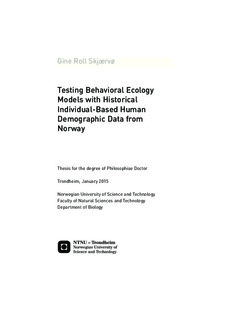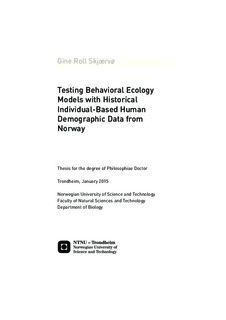| dc.contributor.author | Skjærvø, Gine Roll | |
| dc.date.accessioned | 2015-05-11T13:12:40Z | |
| dc.date.available | 2015-05-11T13:12:40Z | |
| dc.date.issued | 2015 | |
| dc.identifier.isbn | 978-82-326-0694-8 (printed ver.) | |
| dc.identifier.isbn | 978-82-326-0695-5 (electronic ver.) | |
| dc.identifier.issn | 1503-8181 | |
| dc.identifier.uri | http://hdl.handle.net/11250/283517 | |
| dc.description.abstract | Behavior varies widely among animals, both within and between species. An
evolutionary perspective may help us understand the origin of this diversity.
Behavioral ecology models seek to explain much of variation in behavior as
adaptations formed by natural selection. In addition to provide answers why
behavior varies under different ecological conditions, behavioral ecology also
provides insight into the underlying proximate mechanisms. Although theory has
made enormous progress in explaining the diversity of animal behavior, it has
often been difficult to empirically test theory on long-living wild mammals. This is
because generations times are typically long so that adequate transgenerational
data is difficult to obtain. Humans, however, have recorded our own history for
hundreds of years and represent a unique model species for testing behavioral
ecology theories. In this thesis I use individual-based demographic data from two
populations (inland and coastal) in historical Norway (1700-1900) to test
predictions from such theories. I focus on life history traits like brood size (twins
or singletons) and menopause, and explore how environmental factors (wealth,
ecology, maternal parity, and solar activity) can explain variation in human
behavior. First, I tested if parent-offspring conflict (POC) could explain why twins
are so rare in humans (Paper I). One prediction from POC theory is that twins
increase inclusive fitness by the death of a co-twin (‘offspring win’), while twin
mothers benefit from the survival of both twins (‘parent win’). However, the
results indicated that ‘parent win’ but not ‘offspring win’. Thus, POC could not be
a selective force shaping brood size in humans. Next, I studied the interactional
effects of status and ecology on women’s fitness (Paper II). The positive effect of
wealth on fitness was stronger in the inland agricultural than in the coastal fishing
society, indicating that the fitness consequence of wealth may depend on local ecology. The variation in diet may be the proximate explanation for the
differences. Prenatal levels of testosterone decreases with maternal parity. I
predicted that maternal parity may be important for offspring’s subsequent life
histories (Paper III). I found that within mated pairs, the difference between the
parity of their mothers was a strong predictor of each couple’s fitness. Sons born
to mothers of low parity married to daughters from mothers with high parity had
a much higher number of grandchildren than e.g. sons of mothers with high parity
married to daughters of mothers with low parity. The results suggest that the
environmental conditions before birth can have fitness effects that span
generations. Why do women stop reproduce long before they die (Paper IV)? I
tested the ‘Reproductive Conflict Hypothesis’ (RCH) that predicts that both
younger and older generations should experience fitness costs with co-breeding.
Contrary to predictions, younger and older women who co-breed had more
grandchildren than those who did not co-breed. I conclude that menopause might
be understood in the light of both ageing and increased lifespan. Theory predicts
that sexual selection is thought to act more strongly on males than on females.
This is poorly studied in humans. I found that wealth/status was an important
factor for the probability of obtaining a new partner, ultimately influencing the
strength of sexual selection (quantified with the Bateman gradient) on both men
and women in these populations (Paper V). Finally, I tested the hypothesis if high
solar activity during early development affects human life history (survival, fertility
and lifetime reproductive success (LRS)). The results show that a high solar activity
(large number of sunspots) at birth decreased the individual’s survival to
adulthood (in both sexes) and fertility (in low status women). On average, the
lifespan of individuals born in a solar maximum period were 5.2 years shorter,
than those born in a solar minimum period. To sum up, in this thesis I have
focused on fundamental paradigms within behavioral ecology and demonstrated
how their theoretical predictions can be tested using two human populations. As
this procedure was successful, it may inspire future research in other human
populations to be carried out with a similar procedure. | nb_NO |
| dc.language.iso | eng | nb_NO |
| dc.publisher | NTNU | nb_NO |
| dc.relation.ispartofseries | Doctoral thesis at NTNU;2015:13 | |
| dc.relation.haspart | Paper 1: Skjærvø, Gine; Stokke, Bård Gunnar; Røskaft, Eivin.
The rarity of twins: A result of an evolutionary battle between mothers and daughters - or do they agree?. Behavioral Ecology and Sociobiology 2009 ;Volum 63.(8) s. 1133-1140
Is not included due to copyright - available at <a href="http://dx.doi.org/ 10.1007/s00265-009-0745-2" target="_blank"> http://dx.doi.org/ 10.1007/s00265-009-0745-2</a> | |
| dc.relation.haspart | Paper 2:
Skjærvø, Gine; Bongard, Terje; Viken, Åslaug; Stokke, Bård Gunnar; Røskaft, Eivin.
Wealth, status, and fitness: a historical study of Norwegians in variable environments. Evolution and human behavior 2011 ;Volum 32.(5) s. 305-314
<a href="http://dx.doi.org/ 10.1016/j.evolhumbehav.2010.11.006" target="_blank"> http://dx.doi.org/ 10.1016/j.evolhumbehav.2010.11.006</a>
The article in is reprinted with kind permission from Elsevier, sciencedirect.com | |
| dc.relation.haspart | Paper 3: Skjærvø, Gine; Røskaft, Eivin.
Early conditions and fitness: effect of maternal parity on human life-history traits. Behavioral Ecology 2013 ;Volum 24.(2) s. 334-341 <a href="http://dx.doi.org/ 10.1093/beheco/ars185" target="_blank"> http://dx.doi.org/ 10.1093/beheco/ars185</a>
© The Author 2012. Published by Oxford University Press on behalf
of the International Society for Behavioral Ecology. All rights reserved.
For permissions, please e-mail: journals.permissions@oup.com | |
| dc.relation.haspart | Paper 4:
Skjærvø, Gine; Røskaft, Eivin.
Menopause: No support for an evolutionary explanation among historical Norwegians. Experimental Gerontology 2013 ;Volum 48.(4) s. 408-413
<a href="http://dx.doi.org/ 10.1016/j.exger.2013.02.001" target="_blank"> http://dx.doi.org/ 10.1016/j.exger.2013.02.001</a>
This article is reprinted with kind permission from Elsevier, sciencedirect.com | |
| dc.relation.haspart | Paper 5:
Skjærvø GR, Røskaft E. (2015). Wealth and the opportunity for sexual
selection in men and women. Behavioral Ecology
<a href="http://dx.doi.org/ 10.1093/beheco/aru213" target="_blank"> http://dx.doi.org/ 10.1093/beheco/aru213</a>
© The Author 2014. Published by Oxford University Press on behalf of
the International Society for Behavioral Ecology. All rights reserved. For
permissions, please e-mail: journals.permissions@oup.com | |
| dc.relation.haspart | Paper 6:
Skjærvø GR, Fossøy F, Røskaft E. (2015). Solar activity during fetal life
and reproductive success in men and women. Proceedings of Royal
Society B
<a href="http://dx.doi.org/ 10.1098/rspb.2014.2032" target="_blank"> http://dx.doi.org/10.1098/rspb.2014.2032</a>
© 2015 The Author(s) Published by the Royal Society. All rights reserved. | |
| dc.title | Testing Behavioral Ecology Models with Historical Individual-Based Human Demographic Data from Norway | nb_NO |
| dc.type | Doctoral thesis | nb_NO |
| dc.subject.nsi | VDP::Mathematics and natural science: 400::Basic biosciences: 470 | nb_NO |

